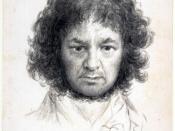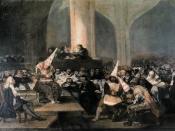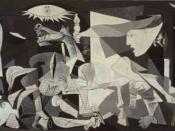Picasso's "Guernica" (1937) and Goya's "The Third of May" (1814) are paintings that are created to communicate an issue of concern of the artist. In order to truly understand the impact that these paintings have on people, and why that impact is so strong, a person must analyse the content of them.
The first reaction of the "Guernica" by Picasso is one of mayhem, destruction, lost souls and death. The entire painting is dark with cool colours and no sign of warmth. There are scattered distorted figures not exactly looking like humans but many figures taking the human form with faces in obvious confusion. The piece is representational and has asymmetrical balance. The visual elements are used very efficiently in respect to lines and colour. The curvature contrasted along with the use of jagged lines helps create the chaotic feeling produced even in the midst of such cool and warm colours.
There is a lot of overlapping figures and not much space between any, but the shading around helps create the feeling of space. There are implied lines within the shading. The artist likely used a limited palette for this painting. The positive shapes are the lightest of the painting and the negative shapes are the darkest and sometimes even empty shapes.
The use of curvature and lines helps create unity. The point of emphasis is established by using lighter shades in the midst of very dark colours. The focal point is likely the bull like figure in the top left because everything is pointed there and all the faces are looking at it.
I believe the main theme of this piece is to show the devastation that can be caused by chaotic or tragic events and how they can affect more than just a few individuals. Picasso...


